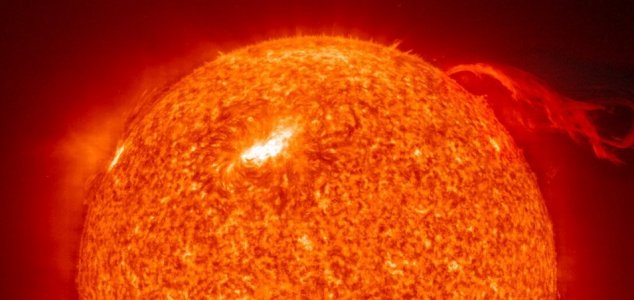Space & Astronomy
May 8, 2018 · 22 comments
22 comments

The Sun will not last forever. Image Credit: SOHO/EIT
Originally formed from the gravitational collapse of matter within a large molecular cloud, our star is 109 times larger (in terms of diameter) and 330,000 times more massive than the Earth.
In around 5 billion years from now, it will expand to over 250 times its current size, swallowing up Mercury, Venus and the Earth as it becomes what is known as a red giant.
Exactly what will happen next however has long remained a topic of debate among scientists, but now an international team of astronomers believe that they may have finally found the answer.
In most cases, as a main-sequence star dies, it will collapse from a red giant in to a white dwarf, producing a glowing ring of gas and dust known as a planetary nebula.
Using a new model that can predict the life-cycle of stars, scientists have now been able to confirm that this is likely to happen in the case of the Sun as well.
"When a star dies it ejects a mass of gas and dust - known as its envelope - into space," said Professor Albert Zijlstra from the University of Manchester.
"This reveals the star's core, which by this point in the star's life is running out of fuel, eventually turning off and before finally dying. It is only then the hot core makes the ejected envelope shine brightly for around 10,000 years - a brief period in astronomy."
"This is what makes the planetary nebula visible. Some are so bright that they can be seen from extremely large distances measuring tens of millions of light years, where the star itself would have been much too faint to see."
Source: Sky News | Comments (22)
Scientists reveal the Sun's ultimate fate
By T.K. RandallMay 8, 2018 ·
 22 comments
22 comments
The Sun will not last forever. Image Credit: SOHO/EIT
When our star eventually dies, it will go out in a blaze of glory and produce what is known as a planetary nebula.
At 4.6 billion years old, our Sun is vital to the survival of all life on Earth and always has been.Originally formed from the gravitational collapse of matter within a large molecular cloud, our star is 109 times larger (in terms of diameter) and 330,000 times more massive than the Earth.
In around 5 billion years from now, it will expand to over 250 times its current size, swallowing up Mercury, Venus and the Earth as it becomes what is known as a red giant.
Exactly what will happen next however has long remained a topic of debate among scientists, but now an international team of astronomers believe that they may have finally found the answer.
Using a new model that can predict the life-cycle of stars, scientists have now been able to confirm that this is likely to happen in the case of the Sun as well.
"When a star dies it ejects a mass of gas and dust - known as its envelope - into space," said Professor Albert Zijlstra from the University of Manchester.
"This reveals the star's core, which by this point in the star's life is running out of fuel, eventually turning off and before finally dying. It is only then the hot core makes the ejected envelope shine brightly for around 10,000 years - a brief period in astronomy."
"This is what makes the planetary nebula visible. Some are so bright that they can be seen from extremely large distances measuring tens of millions of light years, where the star itself would have been much too faint to see."
Source: Sky News | Comments (22)

The Unexplained Mysteries
Book of Weird News
AVAILABLE NOW
Take a walk on the weird side with this compilation of some of the weirdest stories ever to grace the pages of a newspaper.
Click here to learn more

Support us on Patreon
BONUS CONTENTFor less than the cost of a cup of coffee, you can gain access to a wide range of exclusive perks including our popular 'Lost Ghost Stories' series.
Click here to learn more
Israel, Palestine and the Middle-East
United States and the Americas
Science and Technology
Spirituality, Religion and Beliefs
Total Posts: 7,768,241 Topics: 325,020 Members: 203,763
Not a member yet ? Click here to join - registration is free and only takes a moment!
Not a member yet ? Click here to join - registration is free and only takes a moment!


































Please Login or Register to post a comment.